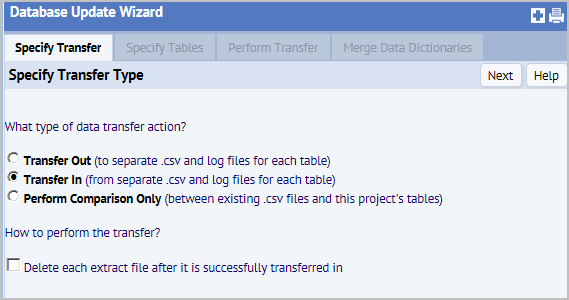
Data that have been exported from one database using the Database Update Wizard can be imported into another database using the Transfer In option of the Database Update Wizard. Some examples of when you need to import data are:
This topic covers imports for all types of data except data that is related to the ARCHIBUS data dictionary. Data dictionary imports have additional considerations and are covered in Performing the Data Transfer: Merge Data Dictionary Tables.
To transfer non-data dictionary data into your database, you will :
The default transfer action is Transfer Out. You need to select Transfer In which copies data from .csv files into the corresponding table in the database.

The Transfer In process looks for .csv files in a folder specific to the logged in user:
ARCHIBUS\projects\users\<this user>
Note that the .csv file location is tied to the user -- not to the project. Assuming that you sign in as the same user to different projects, there is no need to copy files from one place to another when moving data between projects. The name of the file is the same as the table name. For example if you were importing data for the rooms table (rm). the .csv file would be rm.csv.
When performing a Transfer In, you need to specify if the extract files should be deleted after a successful transfer into the database. Deleting the files after that transfer is useful if you are running the wizard multiple times and want to re-run the wizard on just those tables that failed to import in the previous pass. By default, the files will not be deleted.
Click Next to go to the next step: Specify Tables. Once you have identified the tables to transfer, click on Next to go to the Perform Transfer step.
Once you specify the tables to import, the wizard performs the following checks:

Choose the Start Import button to copy data from the database to the .csv files
If you find that you need to stop the import, you can choose the Stop Import button to have the wizard to immediately terminate the transfer. This could result in a table not containing all the records in the corresponding .csv file.
Similarly, you can choose to pause and resume the import. Resuming restarts the transfer at the point it left off.
Why might you want to stop or pause the transfer?
The lower panel displays the progress of the transfer and the number of records in each table. Statuses are:
Click on the ellipsis [...] to view the following additional information.
View Destination Table Drill-down In the column Destination Table, click on […] to load the Default Table View for this table showing all records. Users may wish to use the Smart Search console on the Data Transfer Status field to quickly drill in to records that are Inserted, Updated, or Missing
View Source Extract File Drill-down […] This is a URL link to the .csv extract file, which will display in Microsoft Excel.
View Inserted Records Log […] This is a URL link to the inserted records log produced by Data Transfer (e.g. /schema/per-site/datatransfer/<userid>/<table name>/<userid>-<table name>-inserted.xls ).
View Updated Records Log […] This is a URL link to the updated records log produced by Data Transfer (e.g. /schema/per-site/datatransfer/<userid>/<table name>/<userid>-<table name>-updated.xls).
View Errors Records […] This is a URL that link to the error records log produced by Data Transfer. (e.g. /schema/per-site/datatransfer/<userid>/<table name>/<userid>-<table name>-errors.xls).
| Copyright © 1984-2014, ARCHIBUS, Inc. All rights reserved. |